Presentation: International Trade and Logistics in Australia
VerifiedAdded on 2022/11/13
|10
|1119
|88
Presentation
AI Summary
This presentation, created by an international trader from Australia, delves into the dynamics of international trade and logistics. It begins with a simulation involving the trade of aluminum, wool, and coal, highlighting the impact of economic conditions on trade outcomes. The presentation then identifies key findings, such as the volatility of the global economy and the advantages of free trade. It further analyzes the benefits and challenges of international trade for Australia, considering market access, trade restrictions, and the creation versus destruction of value in different trade environments. The presentation concludes with policy recommendations for Australia, emphasizing the importance of free trade, trader support, and the expansion into service exports. The presentation is supported by a comprehensive list of references. This assignment is available on Desklib, a platform offering AI-based study tools and resources for students.
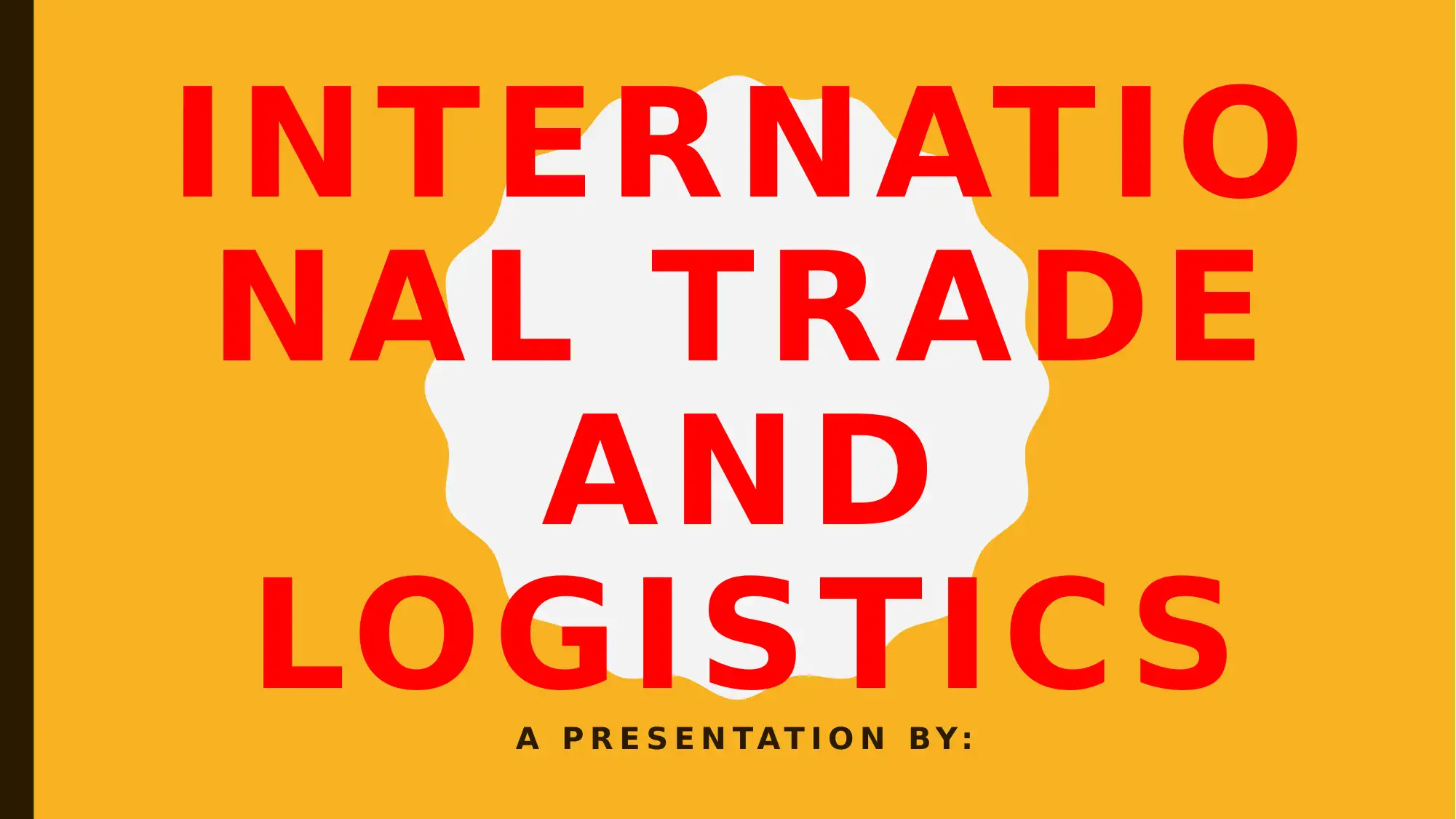
INTERNATIO
NAL TRADE
AND
LOGISTICSA P R E S E N T A T I O N B Y :
NAL TRADE
AND
LOGISTICSA P R E S E N T A T I O N B Y :
Paraphrase This Document
Need a fresh take? Get an instant paraphrase of this document with our AI Paraphraser
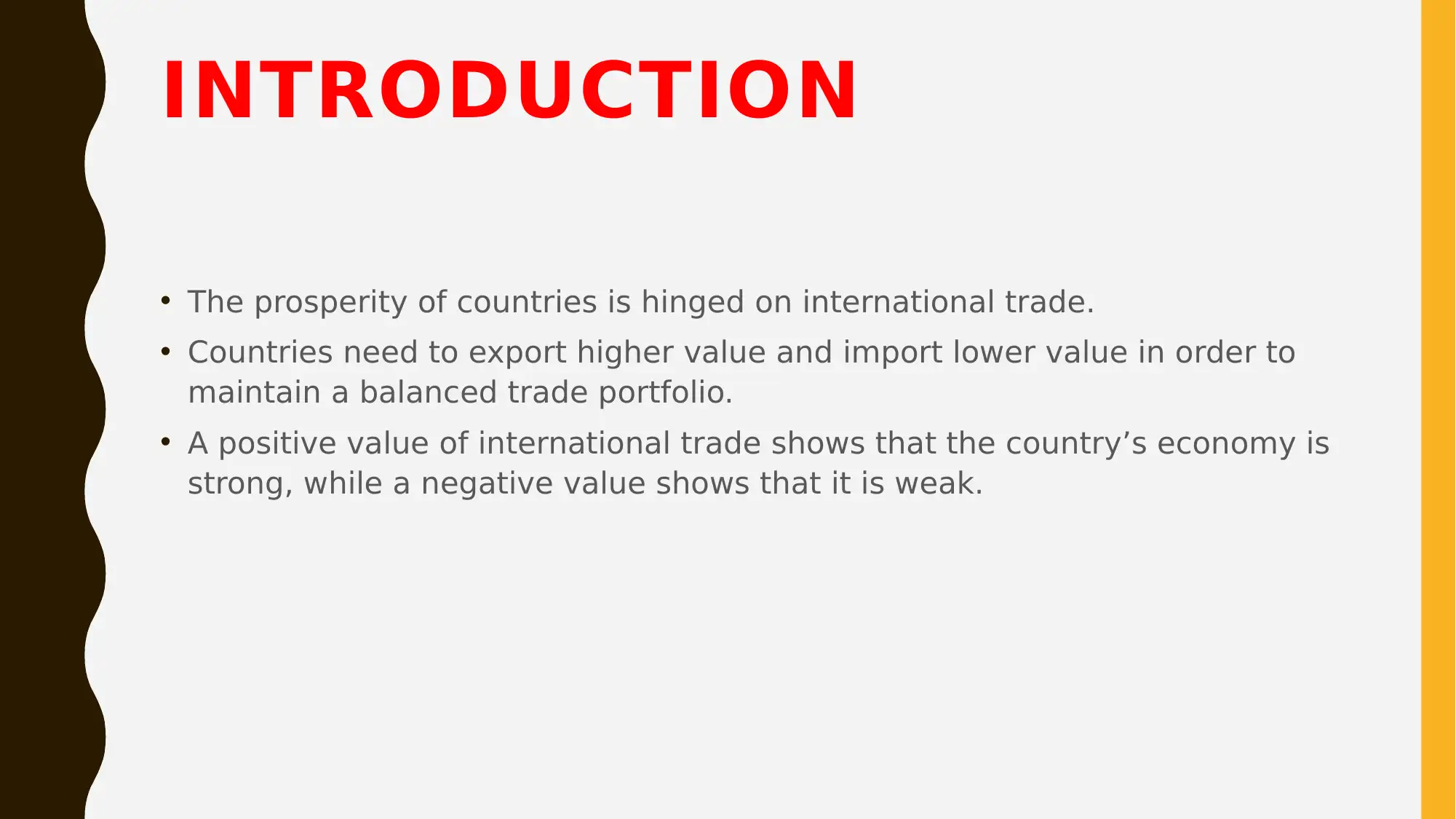
INTRODUCTION
• The prosperity of countries is hinged on international trade.
• Countries need to export higher value and import lower value in order to
maintain a balanced trade portfolio.
• A positive value of international trade shows that the country’s economy is
strong, while a negative value shows that it is weak.
• The prosperity of countries is hinged on international trade.
• Countries need to export higher value and import lower value in order to
maintain a balanced trade portfolio.
• A positive value of international trade shows that the country’s economy is
strong, while a negative value shows that it is weak.
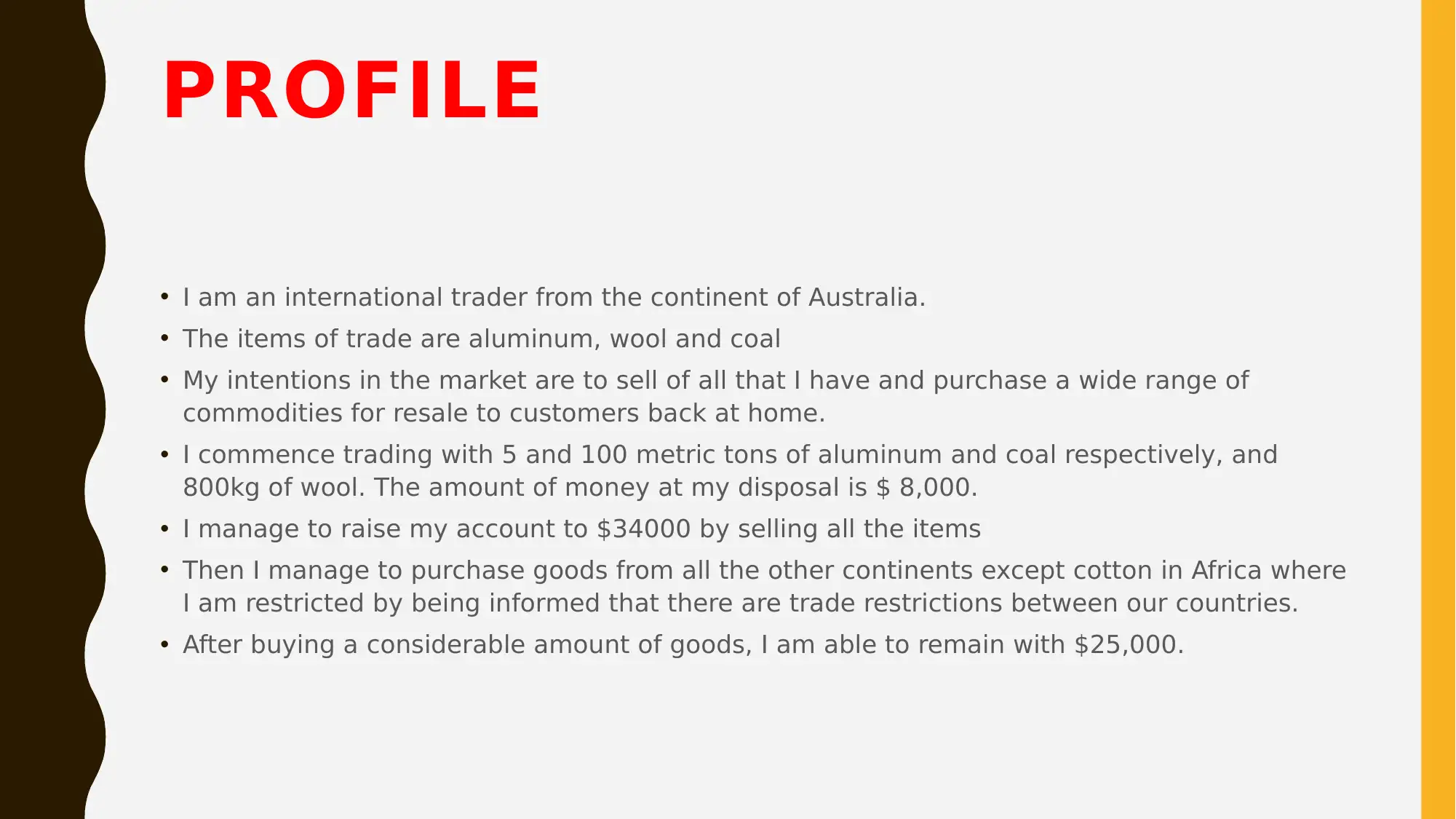
PROFILE
• I am an international trader from the continent of Australia.
• The items of trade are aluminum, wool and coal
• My intentions in the market are to sell of all that I have and purchase a wide range of
commodities for resale to customers back at home.
• I commence trading with 5 and 100 metric tons of aluminum and coal respectively, and
800kg of wool. The amount of money at my disposal is $ 8,000.
• I manage to raise my account to $34000 by selling all the items
• Then I manage to purchase goods from all the other continents except cotton in Africa where
I am restricted by being informed that there are trade restrictions between our countries.
• After buying a considerable amount of goods, I am able to remain with $25,000.
• I am an international trader from the continent of Australia.
• The items of trade are aluminum, wool and coal
• My intentions in the market are to sell of all that I have and purchase a wide range of
commodities for resale to customers back at home.
• I commence trading with 5 and 100 metric tons of aluminum and coal respectively, and
800kg of wool. The amount of money at my disposal is $ 8,000.
• I manage to raise my account to $34000 by selling all the items
• Then I manage to purchase goods from all the other continents except cotton in Africa where
I am restricted by being informed that there are trade restrictions between our countries.
• After buying a considerable amount of goods, I am able to remain with $25,000.
⊘ This is a preview!⊘
Do you want full access?
Subscribe today to unlock all pages.

Trusted by 1+ million students worldwide
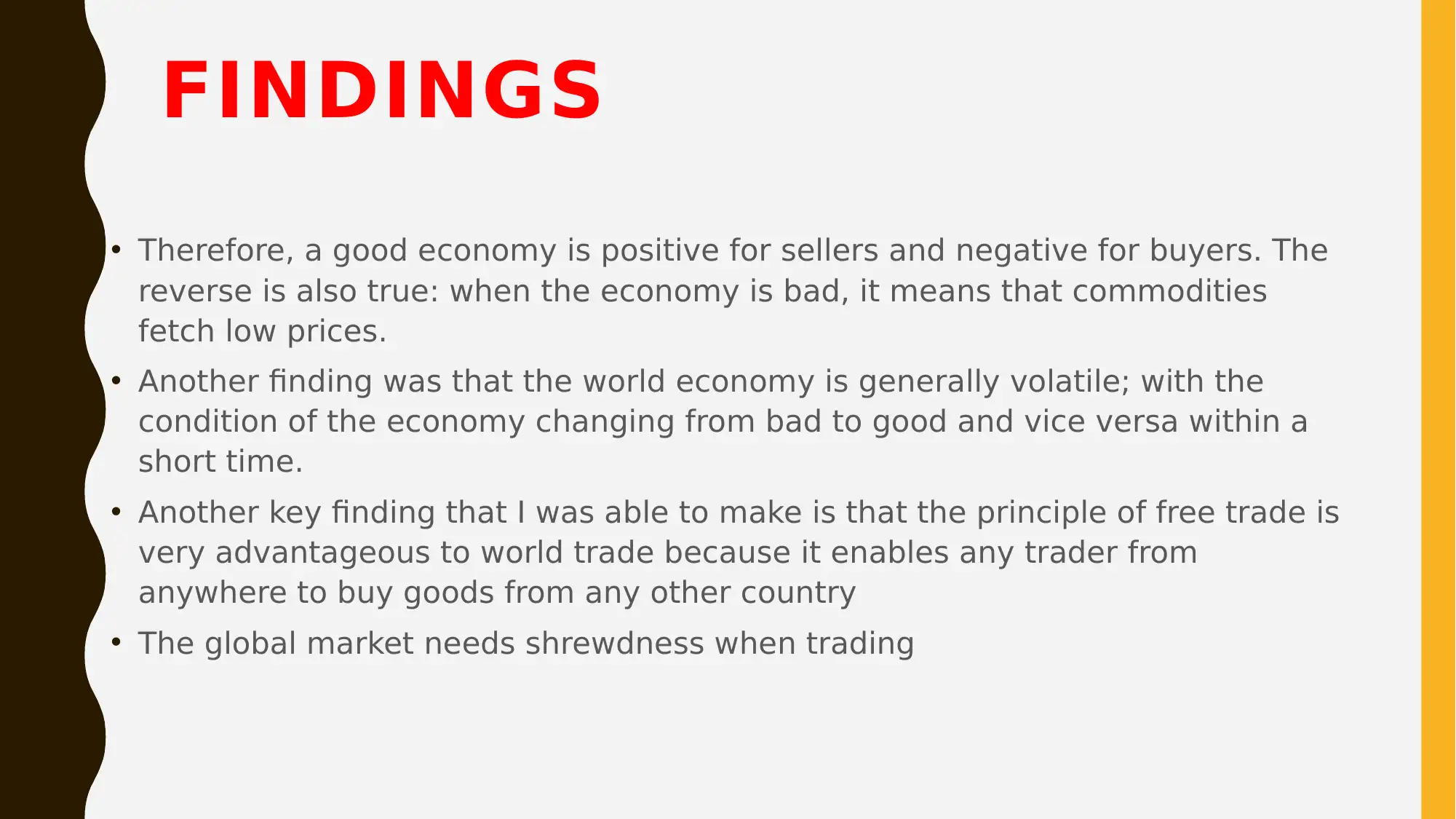
FINDINGS
• Therefore, a good economy is positive for sellers and negative for buyers. The
reverse is also true: when the economy is bad, it means that commodities
fetch low prices.
• Another finding was that the world economy is generally volatile; with the
condition of the economy changing from bad to good and vice versa within a
short time.
• Another key finding that I was able to make is that the principle of free trade is
very advantageous to world trade because it enables any trader from
anywhere to buy goods from any other country
• The global market needs shrewdness when trading
• Therefore, a good economy is positive for sellers and negative for buyers. The
reverse is also true: when the economy is bad, it means that commodities
fetch low prices.
• Another finding was that the world economy is generally volatile; with the
condition of the economy changing from bad to good and vice versa within a
short time.
• Another key finding that I was able to make is that the principle of free trade is
very advantageous to world trade because it enables any trader from
anywhere to buy goods from any other country
• The global market needs shrewdness when trading
Paraphrase This Document
Need a fresh take? Get an instant paraphrase of this document with our AI Paraphraser
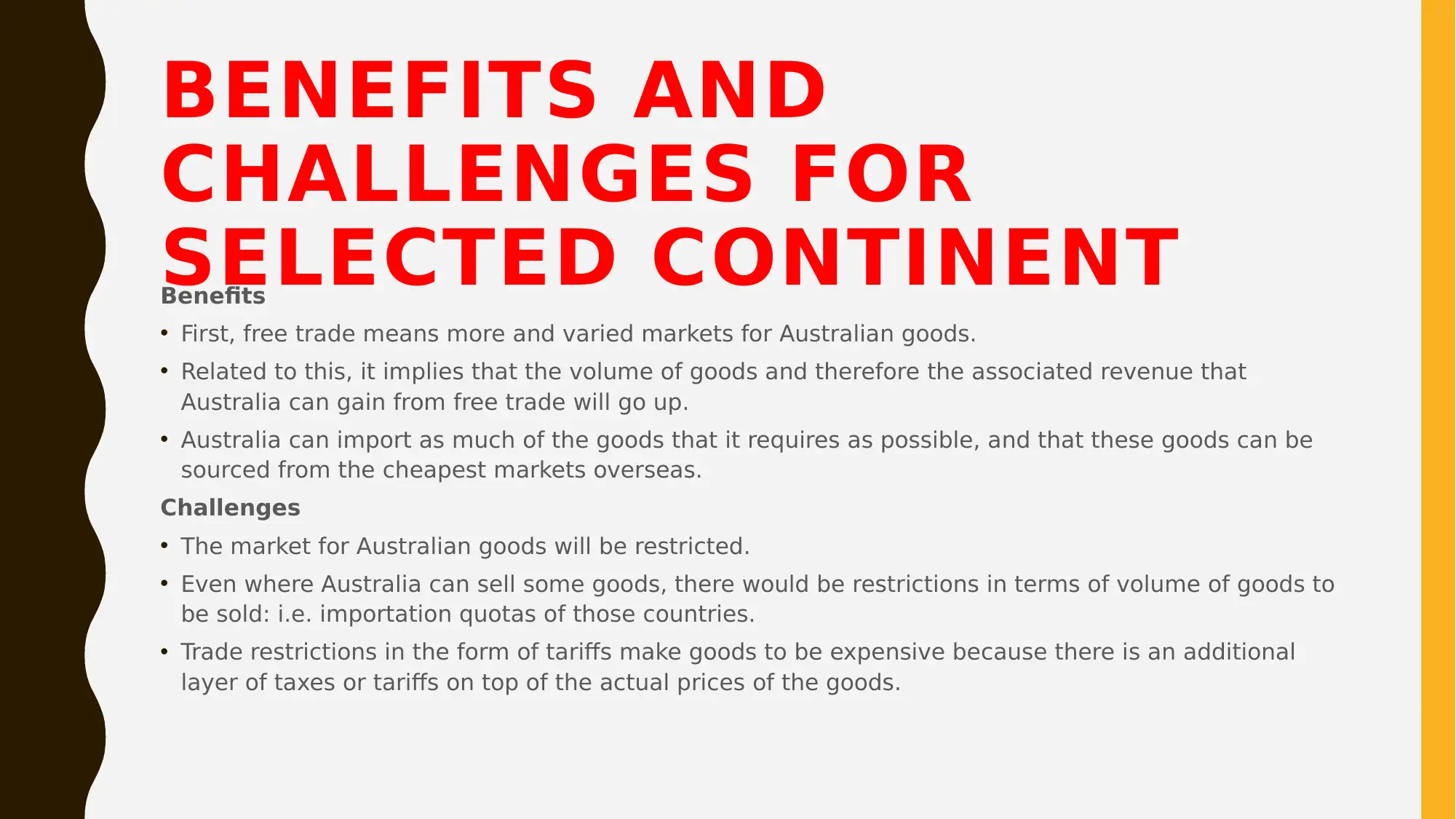
BENEFITS AND
CHALLENGES FOR
SELECTED CONTINENTBenefits
• First, free trade means more and varied markets for Australian goods.
• Related to this, it implies that the volume of goods and therefore the associated revenue that
Australia can gain from free trade will go up.
• Australia can import as much of the goods that it requires as possible, and that these goods can be
sourced from the cheapest markets overseas.
Challenges
• The market for Australian goods will be restricted.
• Even where Australia can sell some goods, there would be restrictions in terms of volume of goods to
be sold: i.e. importation quotas of those countries.
• Trade restrictions in the form of tariffs make goods to be expensive because there is an additional
layer of taxes or tariffs on top of the actual prices of the goods.
CHALLENGES FOR
SELECTED CONTINENTBenefits
• First, free trade means more and varied markets for Australian goods.
• Related to this, it implies that the volume of goods and therefore the associated revenue that
Australia can gain from free trade will go up.
• Australia can import as much of the goods that it requires as possible, and that these goods can be
sourced from the cheapest markets overseas.
Challenges
• The market for Australian goods will be restricted.
• Even where Australia can sell some goods, there would be restrictions in terms of volume of goods to
be sold: i.e. importation quotas of those countries.
• Trade restrictions in the form of tariffs make goods to be expensive because there is an additional
layer of taxes or tariffs on top of the actual prices of the goods.
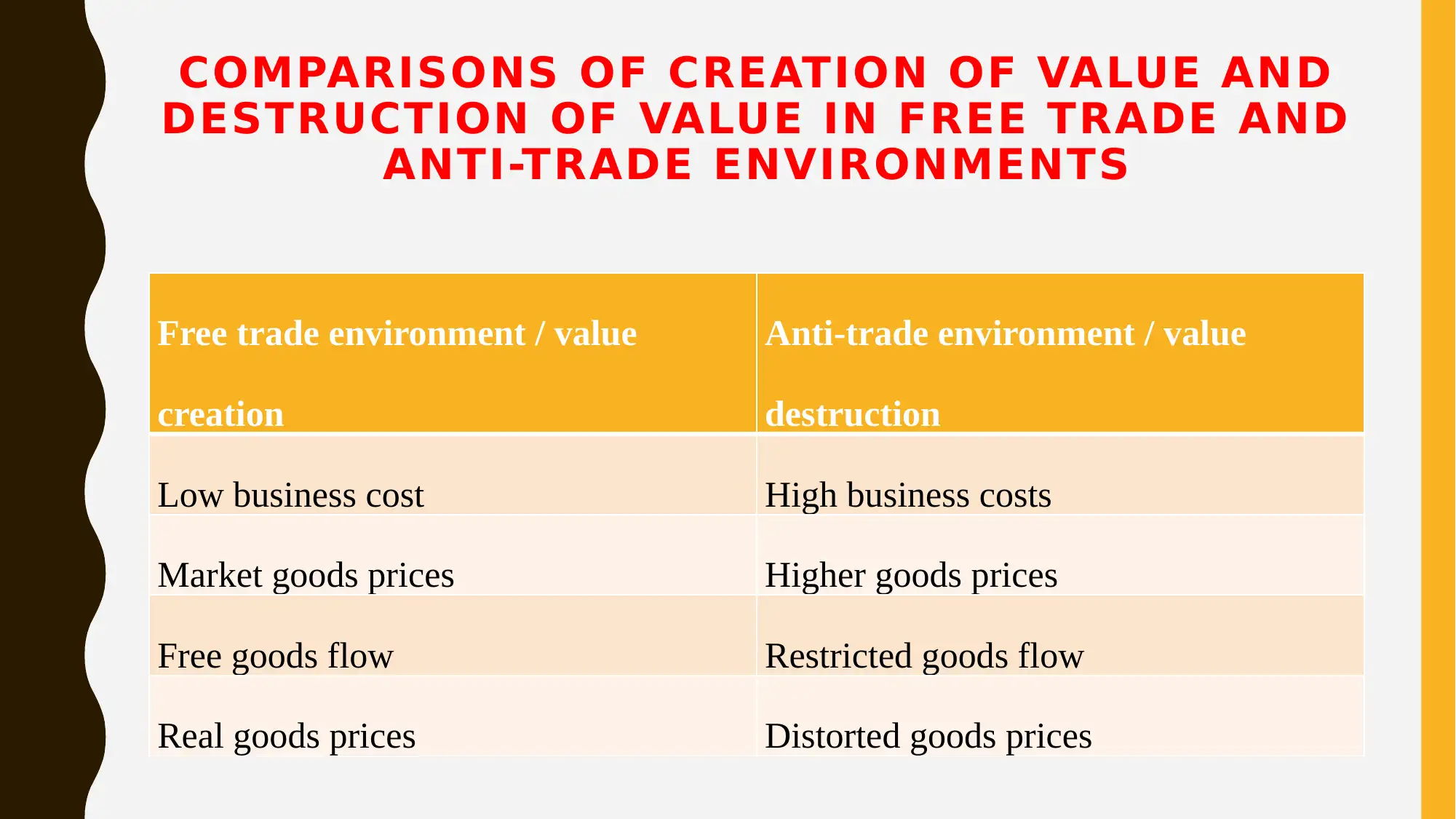
COMPARISONS OF CREATION OF VALUE AND
DESTRUCTION OF VALUE IN FREE TRADE AND
ANTI-TRADE ENVIRONMENTS
Free trade environment / value
creation
Anti-trade environment / value
destruction
Low business cost High business costs
Market goods prices Higher goods prices
Free goods flow Restricted goods flow
Real goods prices Distorted goods prices
DESTRUCTION OF VALUE IN FREE TRADE AND
ANTI-TRADE ENVIRONMENTS
Free trade environment / value
creation
Anti-trade environment / value
destruction
Low business cost High business costs
Market goods prices Higher goods prices
Free goods flow Restricted goods flow
Real goods prices Distorted goods prices
⊘ This is a preview!⊘
Do you want full access?
Subscribe today to unlock all pages.

Trusted by 1+ million students worldwide

CONCLUSION
• It is impossible for a country to operate without international trade since no
country is self-sufficient.
• However, international trade with restrictions is equally harmful, hence the
need for free international trade so that goods that are cheaply produced in
some countries can be sold in others.
• Countries should therefore produce only those goods over which they have
a productive advantage and sell them on the international market.
• It is impossible for a country to operate without international trade since no
country is self-sufficient.
• However, international trade with restrictions is equally harmful, hence the
need for free international trade so that goods that are cheaply produced in
some countries can be sold in others.
• Countries should therefore produce only those goods over which they have
a productive advantage and sell them on the international market.
Paraphrase This Document
Need a fresh take? Get an instant paraphrase of this document with our AI Paraphraser
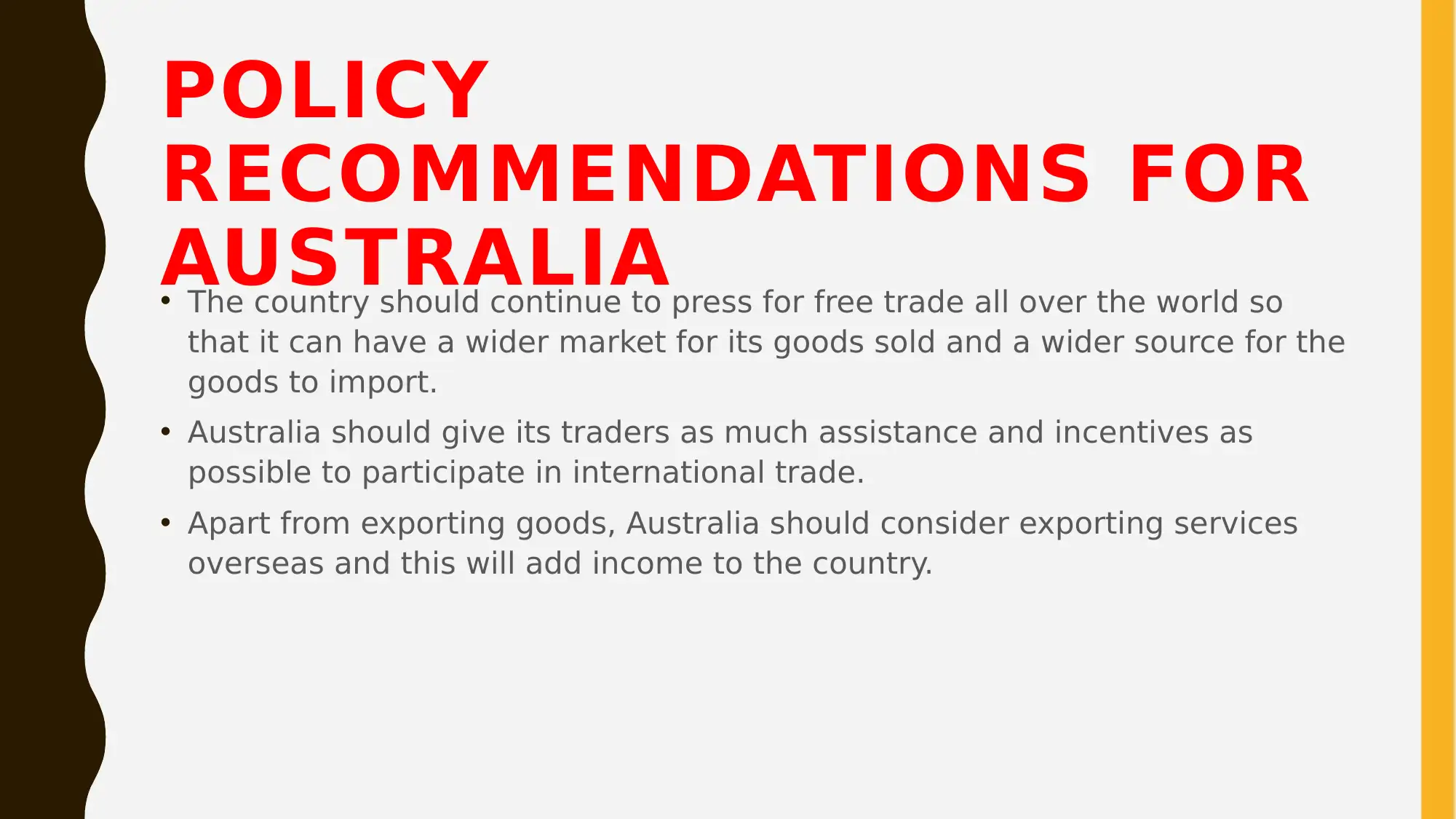
POLICY
RECOMMENDATIONS FOR
AUSTRALIA• The country should continue to press for free trade all over the world so
that it can have a wider market for its goods sold and a wider source for the
goods to import.
• Australia should give its traders as much assistance and incentives as
possible to participate in international trade.
• Apart from exporting goods, Australia should consider exporting services
overseas and this will add income to the country.
RECOMMENDATIONS FOR
AUSTRALIA• The country should continue to press for free trade all over the world so
that it can have a wider market for its goods sold and a wider source for the
goods to import.
• Australia should give its traders as much assistance and incentives as
possible to participate in international trade.
• Apart from exporting goods, Australia should consider exporting services
overseas and this will add income to the country.
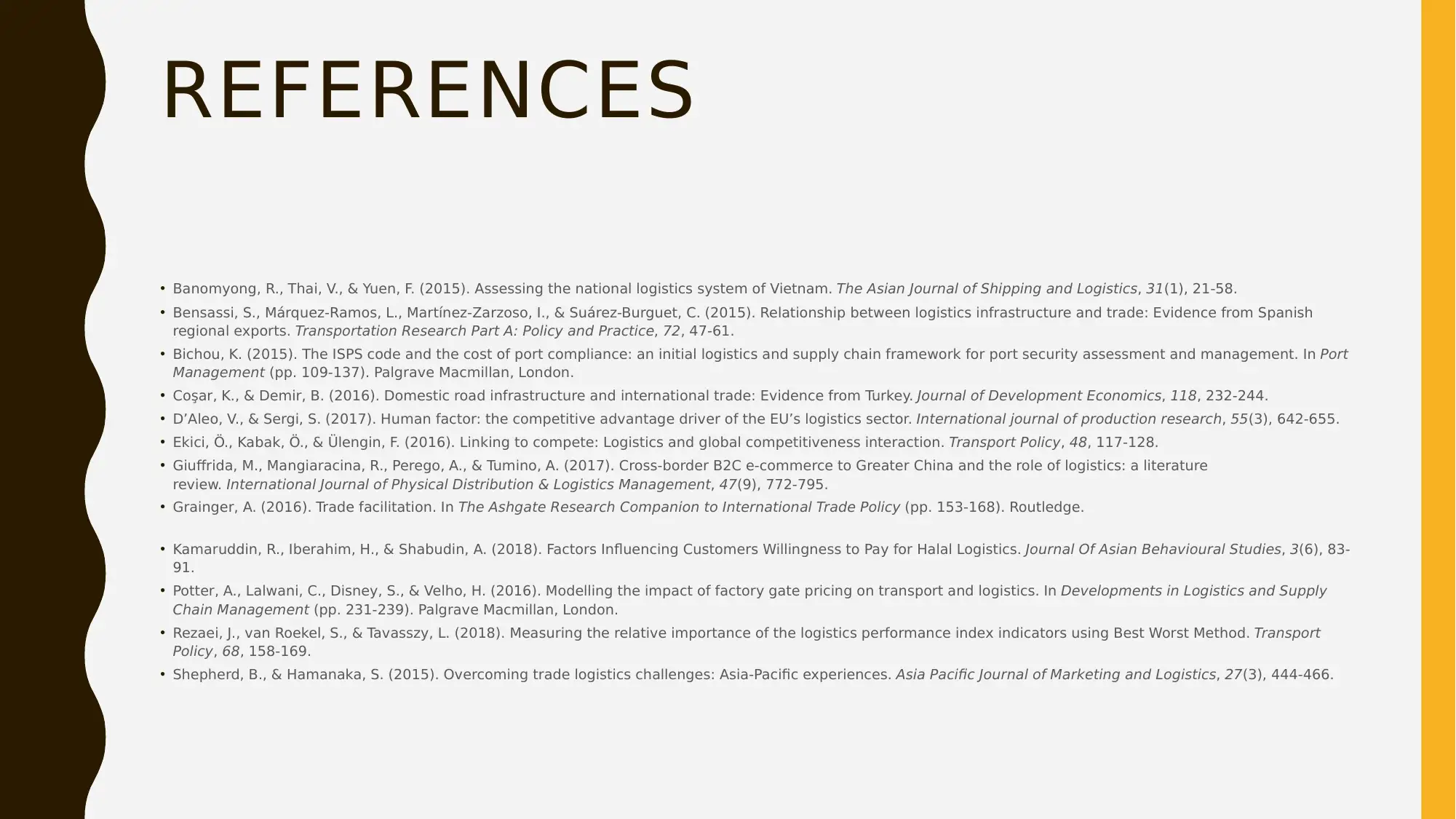
REFERENCES
• Banomyong, R., Thai, V., & Yuen, F. (2015). Assessing the national logistics system of Vietnam. The Asian Journal of Shipping and Logistics, 31(1), 21-58.
• Bensassi, S., Márquez-Ramos, L., Martínez-Zarzoso, I., & Suárez-Burguet, C. (2015). Relationship between logistics infrastructure and trade: Evidence from Spanish
regional exports. Transportation Research Part A: Policy and Practice, 72, 47-61.
• Bichou, K. (2015). The ISPS code and the cost of port compliance: an initial logistics and supply chain framework for port security assessment and management. In Port
Management (pp. 109-137). Palgrave Macmillan, London.
• Coşar, K., & Demir, B. (2016). Domestic road infrastructure and international trade: Evidence from Turkey. Journal of Development Economics, 118, 232-244.
• D’Aleo, V., & Sergi, S. (2017). Human factor: the competitive advantage driver of the EU’s logistics sector. International journal of production research, 55(3), 642-655.
• Ekici, Ö., Kabak, Ö., & Ülengin, F. (2016). Linking to compete: Logistics and global competitiveness interaction. Transport Policy, 48, 117-128.
• Giuffrida, M., Mangiaracina, R., Perego, A., & Tumino, A. (2017). Cross-border B2C e-commerce to Greater China and the role of logistics: a literature
review. International Journal of Physical Distribution & Logistics Management, 47(9), 772-795.
• Grainger, A. (2016). Trade facilitation. In The Ashgate Research Companion to International Trade Policy (pp. 153-168). Routledge.
• Kamaruddin, R., Iberahim, H., & Shabudin, A. (2018). Factors Influencing Customers Willingness to Pay for Halal Logistics. Journal Of Asian Behavioural Studies, 3(6), 83-
91.
• Potter, A., Lalwani, C., Disney, S., & Velho, H. (2016). Modelling the impact of factory gate pricing on transport and logistics. In Developments in Logistics and Supply
Chain Management (pp. 231-239). Palgrave Macmillan, London.
• Rezaei, J., van Roekel, S., & Tavasszy, L. (2018). Measuring the relative importance of the logistics performance index indicators using Best Worst Method. Transport
Policy, 68, 158-169.
• Shepherd, B., & Hamanaka, S. (2015). Overcoming trade logistics challenges: Asia-Pacific experiences. Asia Pacific Journal of Marketing and Logistics, 27(3), 444-466.
• Banomyong, R., Thai, V., & Yuen, F. (2015). Assessing the national logistics system of Vietnam. The Asian Journal of Shipping and Logistics, 31(1), 21-58.
• Bensassi, S., Márquez-Ramos, L., Martínez-Zarzoso, I., & Suárez-Burguet, C. (2015). Relationship between logistics infrastructure and trade: Evidence from Spanish
regional exports. Transportation Research Part A: Policy and Practice, 72, 47-61.
• Bichou, K. (2015). The ISPS code and the cost of port compliance: an initial logistics and supply chain framework for port security assessment and management. In Port
Management (pp. 109-137). Palgrave Macmillan, London.
• Coşar, K., & Demir, B. (2016). Domestic road infrastructure and international trade: Evidence from Turkey. Journal of Development Economics, 118, 232-244.
• D’Aleo, V., & Sergi, S. (2017). Human factor: the competitive advantage driver of the EU’s logistics sector. International journal of production research, 55(3), 642-655.
• Ekici, Ö., Kabak, Ö., & Ülengin, F. (2016). Linking to compete: Logistics and global competitiveness interaction. Transport Policy, 48, 117-128.
• Giuffrida, M., Mangiaracina, R., Perego, A., & Tumino, A. (2017). Cross-border B2C e-commerce to Greater China and the role of logistics: a literature
review. International Journal of Physical Distribution & Logistics Management, 47(9), 772-795.
• Grainger, A. (2016). Trade facilitation. In The Ashgate Research Companion to International Trade Policy (pp. 153-168). Routledge.
• Kamaruddin, R., Iberahim, H., & Shabudin, A. (2018). Factors Influencing Customers Willingness to Pay for Halal Logistics. Journal Of Asian Behavioural Studies, 3(6), 83-
91.
• Potter, A., Lalwani, C., Disney, S., & Velho, H. (2016). Modelling the impact of factory gate pricing on transport and logistics. In Developments in Logistics and Supply
Chain Management (pp. 231-239). Palgrave Macmillan, London.
• Rezaei, J., van Roekel, S., & Tavasszy, L. (2018). Measuring the relative importance of the logistics performance index indicators using Best Worst Method. Transport
Policy, 68, 158-169.
• Shepherd, B., & Hamanaka, S. (2015). Overcoming trade logistics challenges: Asia-Pacific experiences. Asia Pacific Journal of Marketing and Logistics, 27(3), 444-466.
⊘ This is a preview!⊘
Do you want full access?
Subscribe today to unlock all pages.

Trusted by 1+ million students worldwide

END
THANK YOU FOR YOUR TIME!
THANK YOU FOR YOUR TIME!
1 out of 10